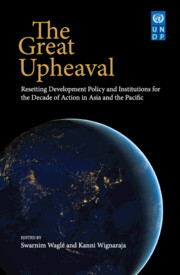Book contents
- Frontmatter
- Contents
- List of Figures
- List of Tables
- List of Boxes
- List of Appendices
- List of Abbreviations
- Foreword
- Acknowledgements
- Introduction
- 1 Aligning Sovereign Debt Financing with Climate Action in the Asia-Pacific Region
- 2 Melting Glaciers, Threatened Livelihoods: Confronting Climate Change to Save the Third Pole
- 3 Accelerating Universal Digital Connectivity
- 4 The Post-COVID-19 Future for Global Value Chains
- 5 Is Southeast Asia Falling into a Latin American–Style Middle-Income Trap?
- 6 Equality of Opportunity as a Measure of Development
- 7 Insights for Policymaking from the Multidimensional Poverty Index
- 8 COVID-19 and Human Security
- 9 Making COVID-19 Vaccine Universally Accessible
- 10 Enhancing the Provision of Global Public Goods: Ready for More Realism?
- 11 Asian-Pacific Regional Cooperation in the Post-COVID-19 Era
- 12 Pandemic Governance and Human Development: Early Lessons from Asia
- 13 Seven Lessons for Development Policy from the COVID-19 Pandemic
- About the Contributors
- Index
9 - Making COVID-19 Vaccine Universally Accessible
Published online by Cambridge University Press: 28 February 2022
- Frontmatter
- Contents
- List of Figures
- List of Tables
- List of Boxes
- List of Appendices
- List of Abbreviations
- Foreword
- Acknowledgements
- Introduction
- 1 Aligning Sovereign Debt Financing with Climate Action in the Asia-Pacific Region
- 2 Melting Glaciers, Threatened Livelihoods: Confronting Climate Change to Save the Third Pole
- 3 Accelerating Universal Digital Connectivity
- 4 The Post-COVID-19 Future for Global Value Chains
- 5 Is Southeast Asia Falling into a Latin American–Style Middle-Income Trap?
- 6 Equality of Opportunity as a Measure of Development
- 7 Insights for Policymaking from the Multidimensional Poverty Index
- 8 COVID-19 and Human Security
- 9 Making COVID-19 Vaccine Universally Accessible
- 10 Enhancing the Provision of Global Public Goods: Ready for More Realism?
- 11 Asian-Pacific Regional Cooperation in the Post-COVID-19 Era
- 12 Pandemic Governance and Human Development: Early Lessons from Asia
- 13 Seven Lessons for Development Policy from the COVID-19 Pandemic
- About the Contributors
- Index
Summary
Of all the products in the world you don't want to use market-based prioritization, it's gotta be vaccines.
—Bill Gates (Financial Times, 2021)INTRODUCTION
Sometime in the first week of February 2021, the global number of vaccinations exceeded the number of identified cases of COVID-19. As of this writing (13 March 2021), the number of cases has passed 118 million, while the number of vaccine doses administered exceeds 345 million. On average, the daily recorded global cases tally around 400,000, and each day also sees more than 8 million vaccine doses administered – a ratio of 20:1. However, 90 per cent of these vaccinations took place in only 11 countries – almost three-fourths of which in the United States, European Union (EU), United Kingdom, China and India, although, the first batch of supplies from the COVID-19 Vaccines Global Access (COVAX) have also arrived in Ghana and Cote-d‘Ivoire (WHO, 2021d; Bloomberg, 2021).
This journey is only one-year old. In March 2020, Yan et.al (2020) published an article detailing the interaction between the now famous spike protein of the SARS-CoV-2 virus and the ACE 2 receptor in human cells to which it binds – the expression of COVID-19 infection at the molecular level. Most of the vaccines now being developed, especially the mRNA and protein antigen viruses, aim to prevent this binding from taking place. The ability to move from a molecular understanding of the virus infection to multiple vaccines in less than nine months is an exceptional affirmation of human ingenuity.
Not all the news is good, however. The case fatality rate (CFR) for February 2021 was about 2.8 per cent, much higher than the cumulative CFR of around 2.2 per cent, although the CFR returned to the average level in March 2021. Also, the progress of vaccination appears very inequitable. Figure 9.1 shows the relationship of deaths normalized as a share of the urban population over age 65 to doses administered as a share of the urban population. A large number of countries that have high death rates have yet to vaccinate a discernible proportion of their populations, while the first countries to begin mass-scale vaccination programmes, such as the United States and United Kingdom, have gone far ahead. Yet both these countries and some European nations remain the most in need, as measured by current fatalities, represented by square markers.
- Type
- Chapter
- Information
- The Great UpheavalResetting Development Policy and Institutions in the Asia-Pacific, pp. 227 - 270Publisher: Cambridge University PressPrint publication year: 2022



